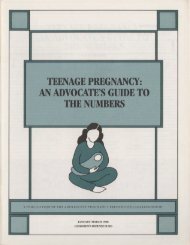child care - Digital Library Collections
child care - Digital Library Collections
child care - Digital Library Collections
You also want an ePaper? Increase the reach of your titles
YUMPU automatically turns print PDFs into web optimized ePapers that Google loves.
CHILO<br />
HEALTH<br />
is, for those who assume the legal responsibility of<br />
paying for their workers' health <strong>care</strong> (although<br />
many such employers use insurance companies to<br />
administer health coverage). Forty percent of<br />
Americans with coverage through work have employers<br />
who self-insure. These workers and their<br />
families are not protected by state statutes regulating<br />
managed <strong>care</strong>; only the federal government can<br />
give them the protection ofconsumer safeguards.<br />
Toward the end of 1997, several events foreshadowed<br />
a major congressional struggle in 1998<br />
over managed <strong>care</strong> safeguards. In November 1997<br />
the President's Advisory Commission on Consumer<br />
Protection and Quality in the Health Care<br />
Industry recommended enforceable, national<br />
standards to strengthen consumers' rights. The<br />
President called for federal legislation to imple.<br />
ment these recommendations. However, while consumers<br />
and others were pushing for stronger patient<br />
protections, opposition began to form among<br />
some insurers, employers, and other interest<br />
groups. Newspapers reported meetings between<br />
such interest groups and the majority leadership in<br />
Congress to plan strategy for blocking enactment<br />
of managed <strong>care</strong> safeguards.<br />
These events were accompanied by the intrcr<br />
duction of major managed <strong>care</strong> legislation with<br />
considerable bipartisan cosponsorship in the<br />
House and Senate. More than 70 health <strong>care</strong> quality<br />
bills were introduced in Congress in 1997, and<br />
advocates of managed <strong>care</strong> reform promised vigorous<br />
action in 1998.<br />
Progress in Maternal and<br />
Child Health<br />
According to data released in 1997 by the National<br />
Center for Health Statistics (NCHS),<br />
fewer women died of complications during<br />
<strong>child</strong>birth in 1995 than in 1994, a higher percentage<br />
of babies were born to mothers receiving early<br />
prenatal <strong>care</strong>, and fewer babies died before their<br />
flISt birthday. At the same time, however, the<br />
percentage of babies born at low birthweight<br />
(5.5 pounds or less) remained at its highest level in<br />
20 years.<br />
Other newly released data from NCHS show<br />
modest health gains for Black <strong>child</strong>ren and pregnant<br />
women in 1995. Infant mortality and low<br />
birthweight were down and prenatal <strong>care</strong> rates<br />
were up, continuing their improvement since 1990.<br />
This has been a welcome trend after nearly a decade<br />
of stagnant or worsening indicators in low<br />
birthweight and prenatal <strong>care</strong> during the 1980s.<br />
Improvement in Black infant mortality in particular<br />
accelerated after the Medicaid expansion in<br />
1989, which was accompanied by a broad range of<br />
community-based efforts to reduce infant deaths<br />
among Blacks. The five years before 1989 saw only<br />
a 3.1 percent reduction in Black infant mortality,<br />
while the mortality rate dropped more than 16<br />
percent between 1990 and 1995.<br />
Following are some key statistics. The appendices<br />
present additional data on rates of early prenatal<br />
<strong>care</strong>, low birthweight, and infant mortality.<br />
• The overall infant mortality rate has been falling<br />
for decades, reaching a record low in 1995<br />
(the latest year for which frnal data are available).<br />
In that year, 29,583 babies died before<br />
their first birthday, putting the rate at 7.6<br />
deaths per 1,000 live births-far below the infant<br />
mortality rate of 17.7 two decades earlier<br />
(see table 2.3). Put differently, had infant mortality<br />
remained at its 1973 level in 1995, nearly<br />
40,000 more American babies would have died<br />
before their flISt birthday.<br />
• Although infant mortality declined among<br />
White, Black, and Hispanic infants in 1995, a<br />
disproportionate number ofBlack babies died.<br />
In 1995 the mortality rate for Black infants was<br />
15.1 per 1,000 live births-more than twice that<br />
for Whites (6.3 per 1,000 live births). Hispanics<br />
had an even lower rate (6.1 per 1,000 live<br />
births), although the r,ates for different groups<br />
ofHispanics vary widely.<br />
• In 1995, 81.3 percent of babies were born to<br />
mothers who received early prenatal <strong>care</strong>, up<br />
from 80.2 percent in 1994.<br />
Good news is also emerging in the battle<br />
against <strong>child</strong>hood AIDS. Between 1992 and 1996<br />
CHI LOR E 'S 0 E FEN S E FUN 0 33














